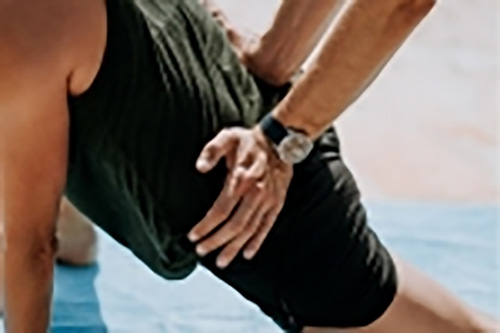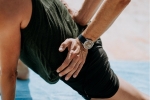 The gluteus medius is a muscle that affects mobility, locomotion and stability for the pelvis and hip joint. This muscle plays an essential role in functional activities such as walking, running, climbing and more. For these reasons, it is beneficial to know how to strengthen the gluteus medius for maximum benefits.
The gluteus medius is a muscle that affects mobility, locomotion and stability for the pelvis and hip joint. This muscle plays an essential role in functional activities such as walking, running, climbing and more. For these reasons, it is beneficial to know how to strengthen the gluteus medius for maximum benefits.
Why is it Beneficial to Strengthen the Gluteus Medius?
Having a weak gluteus medius is closely associated with disruptive movement and an increase in injuries. Hip abduction (HAB) strength can go a long way in reducing injuries in individuals, and strengthening the gluteus medius can help to increase HAB strength. It is also beneficial to strengthen the gluteus medius since it is susceptible to a wide range of pathological conditions such as hip arthritis, chronic back pain and knee pain.
One form of hip arthritis that affects the hip joint is greater trochanteric bursitis, which occurs when the bursae becomes irritated and inflamed. What causes trochanteric bursitis depends on the individual. Some develop it due to muscle tears, hip injuries, hip surgery complications or through engaging in certain activities that overuse or injure the joint’s area. It can also occur as a result of calcium deposits in the joints.
Physical therapy can help this condition, as well as others like it. Through physical therapy, an individual can ease their symptoms while also increasing their hip flexibility and strengthening their gluteus medius. An expert physical therapist can show an individual how to work the gluteus medius muscle group.
How to Work the Gluteus Medius
There are plenty of exercises available for individuals who wish to strengthen their gluteus medius and improve the function of their hips, knees and back. Listed below are six gluteus medius exercises you can partake in to strengthen this muscle.
1. Prone Glute Stretch
To begin this stretch, you must have your feet planted hip-width apart. Next, you lower your knees to the ground and bend one leg so it is perpendicular to your body. The opposite leg becomes extended until that thigh touches the floor. The upper body becomes bent as you use your forearm or elbow to support yourself against the floor.
This stretch is best held for 15 to 20 seconds before moving on to the next side and repeating the same process.
2. Wall Glute Stretch
This stretch is done with the help of a wall. For this stretch, you must sit facing the wall and then raise your feet against the wall. If done correctly, your thighs will become parallel to the wall. Next, the legs become crossed so the left ankle is resting just below the right knee. To complete this stretch, the left knee needs to be stretched outwards toward the wall.
Like the previous stretch, this position should be held for 15 to 20 seconds before repeating with the opposite side.
3. Seated Spinal Twist
This exercise can feel a bit like playing hokey pokey. You begin this one by sitting on the floor with your back straight and your legs together. Next, you bend your right leg at the knee and bring the right foot over the left leg. Then you put your left hand to your right knee, while the right-hand rests on the ground. To complete the stretch position, the individual must twist their upper body to the right.
Again, this pose is held for 15 to 20 seconds before the individual switches to the other side.
4. Bridge
To begin this stretch, lie on your back with your arms beside you. Then, with your feet planted against the floor, bend your legs at the knees while lifting your upper body and hips. When done correctly your body will be aligned in a straight line. To complete the exercise, bring your hips back to the floor and repeat the previous process 10 to 15 times for maximum gluteus medius stretching.
5. Lateral Band Walks
For this exercise you will begin at one wall. You will also need a lateral band, which you will wear around your ankles. Once the band is in place, place your feet hip-width apart while keeping your back straight. Once you push in your abdomen, you will need to get into a squat position.
Next, you will take a lateral step forward with one foot, and then another lateral step with the other. You have now completed one step. Repeat taking these lateral steps until you reach the opposite wall, and then turn around and take lateral steps back to the wall you began at. You have now completed this exercise.
Still wondering about how to strengthen the gluteus medius? Read on.
6. Tabletop Hip Stretch
For this exercise you need a tabletop that reaches the height of your pelvis. If a tabletop is not available or does not reach that height, another platform that does will work as a substitute.
To begin the stretch, you need to lift your leg on top of the table or other platform so your calf and outer thigh is against the platform’s surface. Your upper body should be upright and straight, and so should your other leg. Hold this pose for the usual 15 to 20 seconds before switching to your other leg.
This exercise is great because it stretches not just the gluteus medius but other muscles in the buttocks as well. Additionally, it does not put pressure on the spine and helps relieve inflammation and irritation, which is great for those who have greater trochanteric bursitis.
Schedule an Appointment Today
These exercises are based on ways on how to strengthen the gluteus medius. Dr. Benjamin Domb is an orthopedic surgeon who specializes in sports medicine, regenerative medicine and arthroscopic hip surgery.
Schedule an appointment today if you would like innovative treatment for your hip condition.

